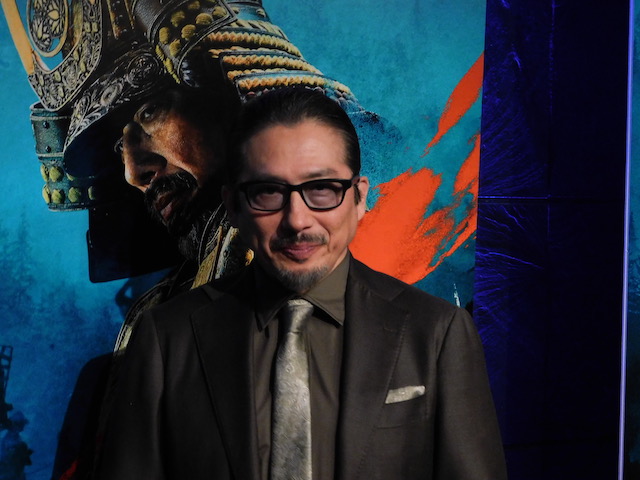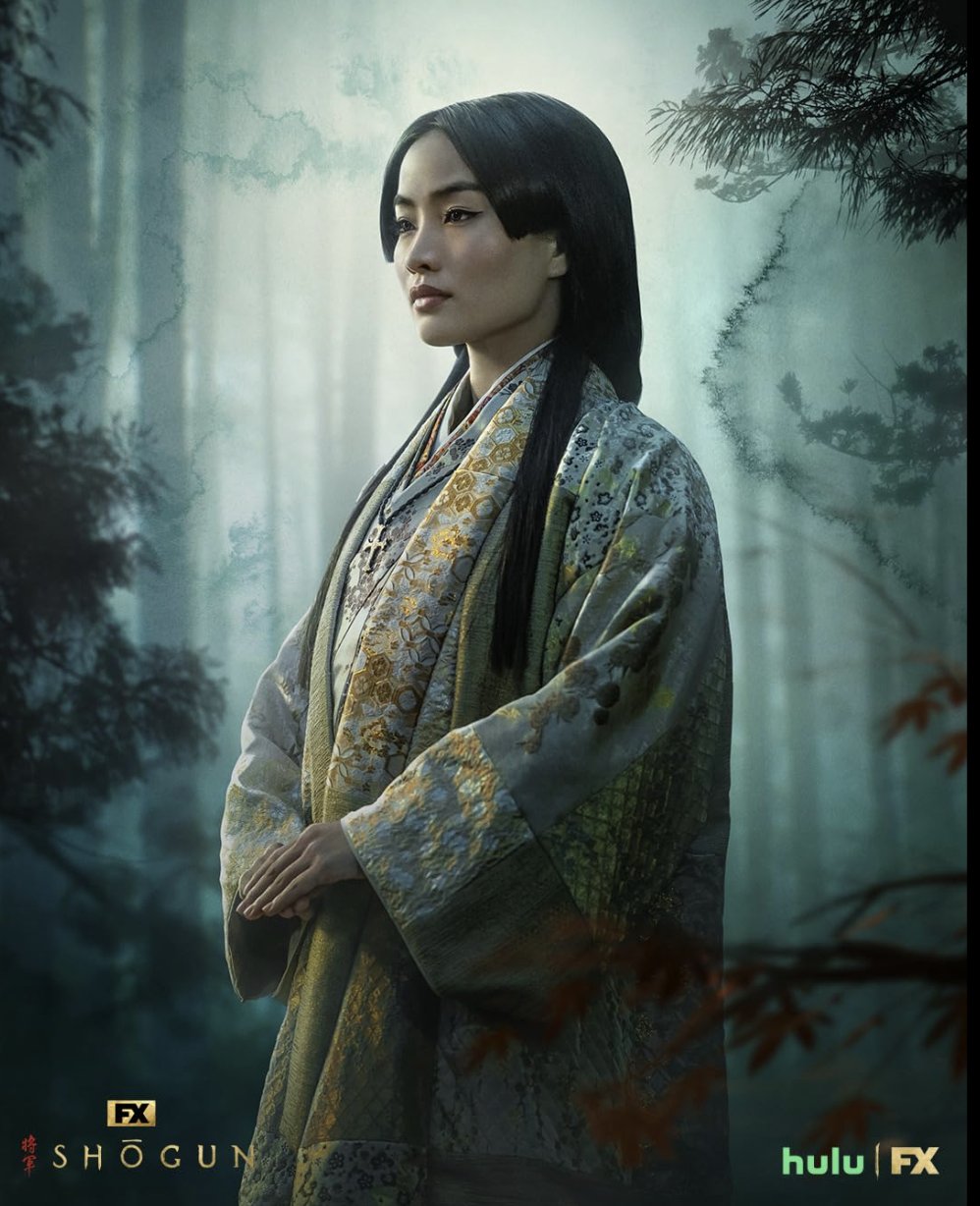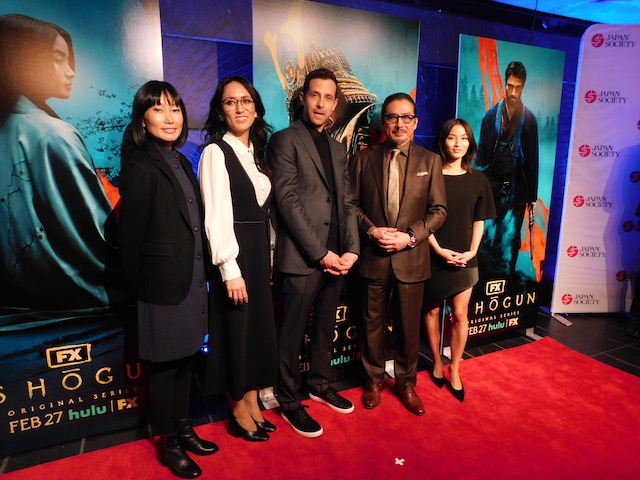
©Photo by Nobuhiro Hosoki
I had a chance to speak with cast Hiroyuki Sanada, Anna Sawai and Producer Eriko Miyagawa of a highly anticipated series, “Shōgun” at the Japan Society.
Shōgun : Set in Japan in the year 1600, Lord Yoshii Toranaga is fighting for his life as his enemies on the Council of Regents unite against him, when a mysterious European ship is found marooned in a nearby fishing village.
Executive Producers : Rachel Kondo, Justin Marks, Edward L. McDonnell, Michael De Luca
Screenwriter : James Clavell
Network : Hulu
Rating : TV-MA
Genre : Dram, War
Original Language : English, Japanese
Release Date : Feb 27, 2024

©Courtesy of FX
Exclusive Interview with Actors Hiroyuki Sanada, Anna Sawai, Producer Eriko Miyagawa
Q: How do you try to make it so authentic?
Hiroyuki Sanada: Sometimes, there are misunderstandings about Japanese culture in Hollywood movies. During the last 20 years, I gained a lot of knowledge. What’s the problem? How can we change the history between East and West? That’s why we hired a Japanese specialist. The crews of experienced Samurai movie makers are responsible for preparing costumes, props, and mastering gestures for every actor and department.
It was really important to me to change the history of Hollywood. The western crew and cast worked together effectively, as did the Japanese crew and cast. You are familiar with the concept of working together, respecting each other, learning about each other, and then attempting to create something unique that no one will ever see. We were an East-meets-West dream team.
Q: You are portraying Toranaga based on a real historical figure Tokugawa Ieyasu. Did you have any ideas for creating this character or did you read specific books to get started?
Hiroyuki Sanada: I had the opportunity to watch the original series on time in the ‘80s, but I hadn’t read the original story at that time. When I received the offer to play Toranaga, I read the original story for the first time and questioned why I was telling this story and playing the role of Toranaga. I was aware that Toranaga was inspired by the accomplishments of Tokugawa Ieyasu [the Shogun]. In this day and age, where there’s still constant strife, I believe that [knowing about] this type of hero is necessary.
Q: Were there any obstacles you faced in the production of this film that were distinct from those you previously faced as an actor?
Hiroyuki Sanada: Rather than being difficult, it was only interesting. Up until then, I had been involved in productions and given advice on matters related to Japanese culture. But I have only performed this task as an actor, and at times, there were numerous errors that I couldn’t fix. Even if I had the ability to say, I was unable to voice them. For the first time, I had the title of producer, and was able to call in crew members from Japan who were well-versed in period dramas. We were able to assign them to each department as Team Japan.
This was an unprecedented leap forward, and it was a fantastic opportunity to change what we had been struggling to change by working together, speaking clearly and without hesitation, and for everyone to hear us. The importance of the producer’s title and the difference between them became apparent to me upon entering the set for the first time. Perhaps it is somewhat similar to how the Toranaga in this story did not want the title of Shogun, but as a result of obtaining it, he was able to build a world of peace.
Obtaining the Producer title allowed me to move forward with my goal of making this work something that the Japanese people could appreciate. I made progress towards the goal I had set for myself, which was to produce a film that Japanese viewers would not be disappointed in seeing. There is an overlap between those two roles as a producer and an actor, and it’s a little strange somehow, but there is an overlap between my position as a producer in this production and the position of Toranaga in this drama, and when I stood in front of the camera, it was like some kind of freedom or reward, more than at any other time in my career! It was like a reward for all the time I was standing in front of the camera.
After all that preparation, I can focus on my own work at this moment. In fact, I was more relaxed than usual, and I was able to enjoy the act itself. I spent more time as a producer than as a performer, so it was a real treat to be in front of the camera. But there is an overlap between my position as a producer in this production and the position of Toranaga in that drama, and when I stood in front of the camera, it was like some kind of freedom or reward, more than at any other time in my career!
Q: Can the two separate roles, as an actor and producer, work together in a positive way?
Hiroyuki Sanada: Yes, I think I was able to become more selfless and enjoy myself more for the first time as a producer because I enjoyed working on the set every day. I never felt that it was hard work at all. The pleasure of being involved in the creative process from start to finish and being given the opportunity to do it all was much greater than the pressure and hard work. Now, having finished the project and it’s about to be released to the world, I’m feeling both happy and sad. It seems to me that the project is already on its own.

©Courtesy of FX
Q: Anna, what was your first impression when you read the original book?
Anna Sawai: When I read it, I had already booked the role. I was just trying to take in all the information and knew that we weren’t going to remake the book 100%. We were trying to add a new perspective to it, and I was really happy when I had my conversation with producer Justin Marks. He made sure that he wanted to make something that felt real to us and he was ready to trust and respect us. He delegated to the Japanese supervising producers and the producers that came [on board].
Q: Considering how authentic this series is, what kind of research did you do to soak yourself into the character. So much of it is not just learning the Japanese language, but also the mannerisms and the culture.
Anna Sawai: Yes, I read books on Hosokawa Garasha, obviously because she is the inspiration for Mariko, I worked with a lot of Shosa [“the way one moves”] teacher. I had lessons with a lot of coaches that were also there in Vancouver to make sure that we [the cast] were doing everything right. My lady in waiting, Jijo no kata, is Kobayashi Atsuko, who was my Shosa teacher. It was just amazing to have people that knew it so well right next to me, so that everything that I was doing wrong, could be corrected right away.
Q: Particularly that was the case with somebody like Hiroki Sanada, who has done period pieces in the past so he became a producer on this series. Talk about how much he helped you to prepare your role. Also, because he was involved as the producer, how helpful was he to make it so authentic.
Anna Sawai: He was involved in every single aspect; he was always there. The first time I did lines with him, he was giving me advice. I was only getting used to it, and anything, from the movement of women, to the way to use the Naginata (a Japanese pole weapon) Even though men don’t use Naginata, he knew everything. He showed me every step of the way. Even on weekends, if I had questions, I would text him and he would give me advice on the lines. If I wanted to change them, he would give me a couple of options. I truly wouldn’t have been able to get through this without his help.
Q: By doing this series, what the things did you learn about Japanese culture that you could apply to your life — what were the things that you remembered most?
Anna Sawai: There’s so much that I learned that it’s hard to put it into a couple of sentences. One thing that I remember right now is how Japanese people don’t say a lot. It used to frustrate me. But then, doing the tea ceremony scene and learning Ocha, and seeing that women, the people, wouldn’t like to talk and discuss how good or how beautiful the teacup was, they would just absorb it.
And they would take their time, and that kind of taught me, Okay, Japanese people came from that. And that’s why we don’t express a lot, even though we think it. So, things like that, once I understood, it was just, I find more beauty in the things that I used to not understand.
Q: In following your career through “Pachinko,” “Monarch: Legacy of Monsters” and this one — congratulations.
Anna Sawai: Thank you so much.
Q: What are you working on next?
Anna Sawai: I’m just doing a lot of press right now for Shogun. We still have a couple more stops to go, and once that’s done, I’m going to think about what I want to do next, because I want to be careful. Since this is so meaningful, and is something that we all poured our heart into, I want to make sure that the next thing I choose to do is something that’s good enough, or even better.

©Photo by Nobuhiro Hosoki
Q: Eriko, how did you and Hiroyuki Sanada prepare for your involvement as producers of “Shogun” in advance?
Eriko Miyagawa: Well, it was already clear that Mr. Sanada was committed to doing a thorough job, so it was my position and responsibility to support him. How could I support him and what he was pursuing as a producer while he was playing the lead role?
Q: You were very careful about the Japanese language used in the film. It’s important to use the language that was used at the time, as well as the language that’s easy for us modern people to understand. How did you take care of that when translating and visualizing the original work?
Eriko Miyagawa: It is difficult, isn’t it? It was necessary to use a period language yet be understandable to people of today. The script was based on English, and it was written by a talented screenwriter. I had a talented team of translators in Japan handle the text, while preserving the nuances and intentions of the script to the maximum extent possible. In balancing these three factors. I requested Kyoko Moriwaki — a scriptwriter who has experience working on period dramas — to translate it into the language of the period to make it more natural for the actors.
On the set, Mr. Sanada, me, and the producer would always check on the monitors to see what the actors were saying, what they thought was unnatural, or if there was any fault with their acting, and determine if we should proceed with it in a particular manner.
After post-production, we would do ADR [automated dialogue replacement] and various other things, and would say, “I tried that, but it doesn’t sound right,” or “How about rewording this?” I kept polishing and polishing until the very end.
Q: English speakers Anna Sawai and Cosmo Jarvis were also involved in this film. They had studied their manners and so on well in advance. How did you prepare them beforehand so that they would blend in with the Japanese culture?
Eriko Miyagawa: Yes, what looks easy at first glance is extremely difficult, so they started taking lessons in Japan as soon as they were selected as actors. I also told them to practice wearing yukata [a single-layered cotton kimono, usually worn in summer] in their daily lives if possible, and to watch a lot of historical dramas. Some of them, especially the younger generation folks, had only worn kimonos a few times in their lives, so it was important to train them. They had to practice over and over again.
Q: The costumes were made with great attention to detail. How meticulous were you and Mr. Sanada when it came to preparing period kabuto [the traditional combat helmet] and armor?
Eriko Miyagawa: We were extremely particular about the costumes. Carlos Rosario, a French designer who worked on this series, and Kazuko Kurosawa (daughter of legendary director Akira Kurosawa), a Japanese consultant, worked with us and gave us general advice, though not so detailed. To put a finer point on it, there was a person, Mitsuru Otsuka, who worked as Kazuko Kurosawa’s right-hand man, we had him involved in this film. He was recently involved in actor Takuya Kimura’s “The Legend & Butterfly,” and is really a specialist in period drama costumes — he supported Carlos on a daily basis. For example, he would send me samples of film production company Toei’s period dramas and we would use them as models for costumes. These period drama costumes are very difficult to make, and the details differ depending on the time, situation, location, hierarchy, etc. So he gave Carlos advice on these details and then he studied them.
Check out more of Nobuhiro’s articles.
Here’s the trailer of the series.

